#Garments IE work
Text
Garments IE work Area..
IE department is the important part of the Garments industry, they must perform some basic tasks on a regular basis. Today I will try to classify garments ie work area & regular activities and dealings in a short to make you understand their importance in apparel industry. Let's take a quick look at their regular garments ie work area.
The primary function of the IE team is to hire skilled labor for the production floor, provide training, evaluate worker performance, motivate workers, reduce loss time and waste, and maximize profit margins. I attempted to combine regular activities and duties of the IE department that they typically perform in order to improve product quality and productivity.
Garments IE work area
Industrial Engineering - IE is a popular term in the industry, where this garments ie work is used to optimize complex processes within the industry. Men, machines, materials, methods, and monetary resources can all benefit from optimization.
0 notes
Text
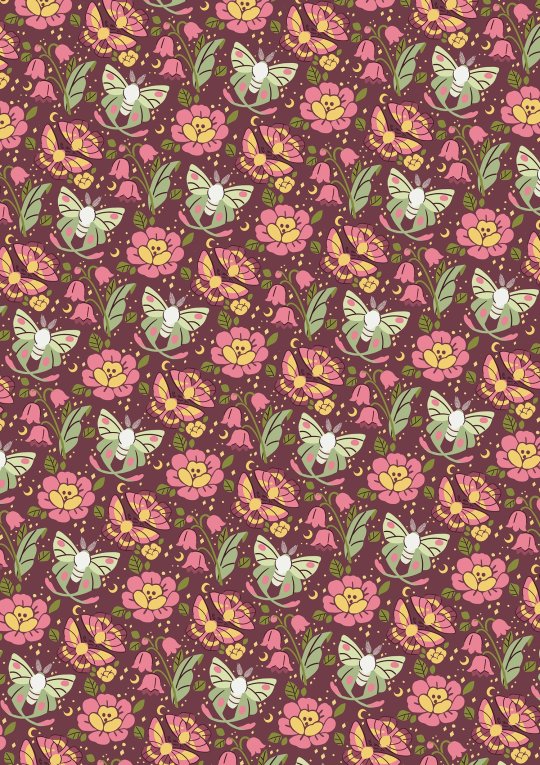

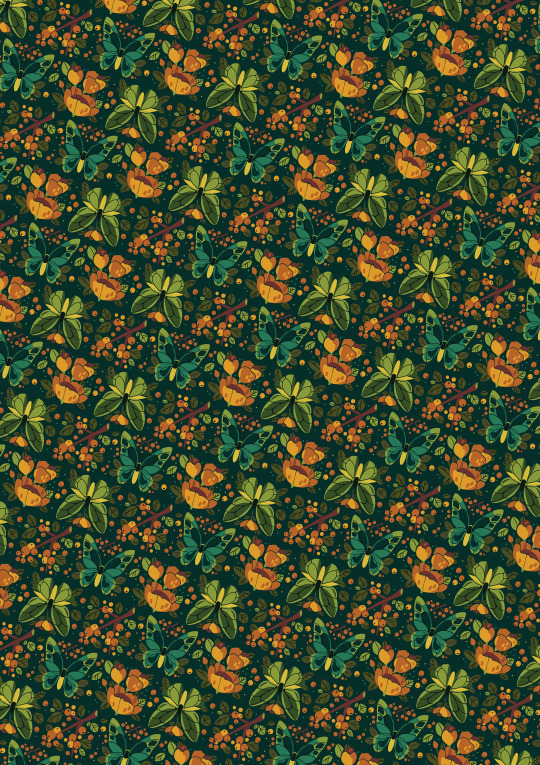
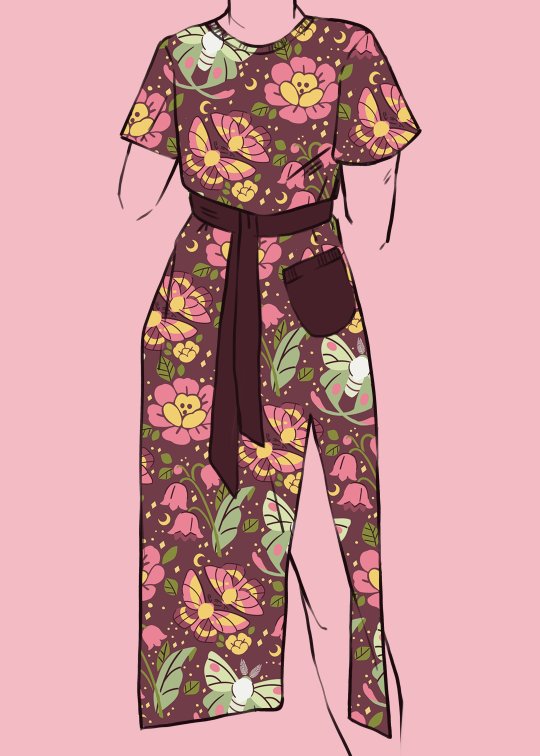
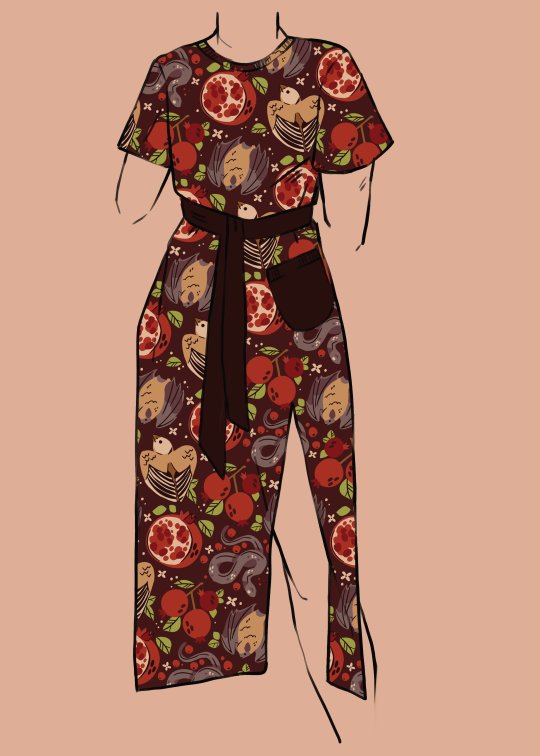
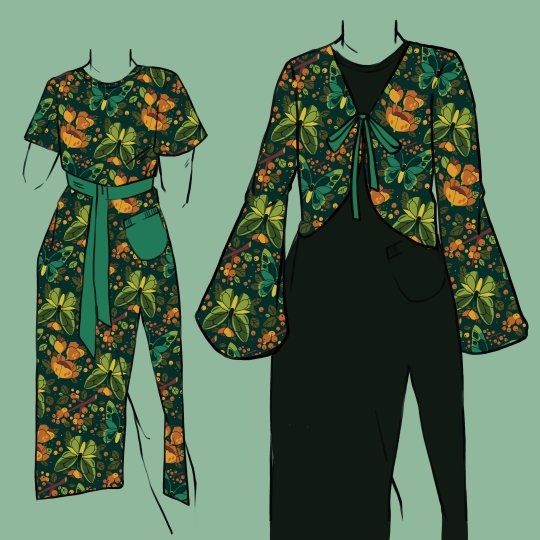

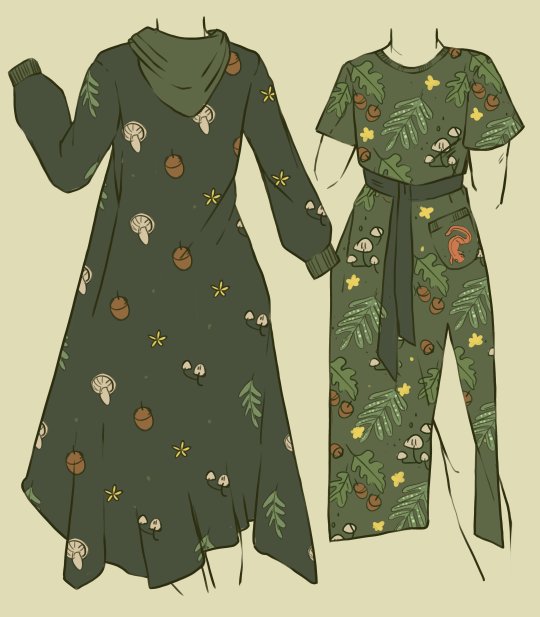

well everyone - im going FULL TILT into designing knitwear this year
earlier this year i teased a sample of a fair isle style sweater, and i was like, why stop there?? so now im also working on samples for knit midi dresses with a removable waist tie, short bell-sleeved cardigans with a removable front tie, and flouncy longline cardigans!! all 100% cotton, varying weights, with the designs knit into the garment like the sweaters. (also the slit on the dress wont go so high up, this was an initial sketch)
these are still in the sampling phase but im hoping i can have them ready for the Ephemera release this year! which miiight be a presale situation, depending on what i want to include.
(also as a disclaimer certain core details wont be changing, ie the bell sleeves for the short cardis)
what other kinds of knitwear do you guys like? i wanna do something with a fun dramatic collar too >:3c
783 notes
·
View notes
Note
hi! fellow malaysian here! i saw your pants patterns recs and i wondered if you have top patterns recs too? esp ones thatll work well for the current weather but isn't too revealing? (eg: sleeveless tops that do not have a low neckline) tqvm!
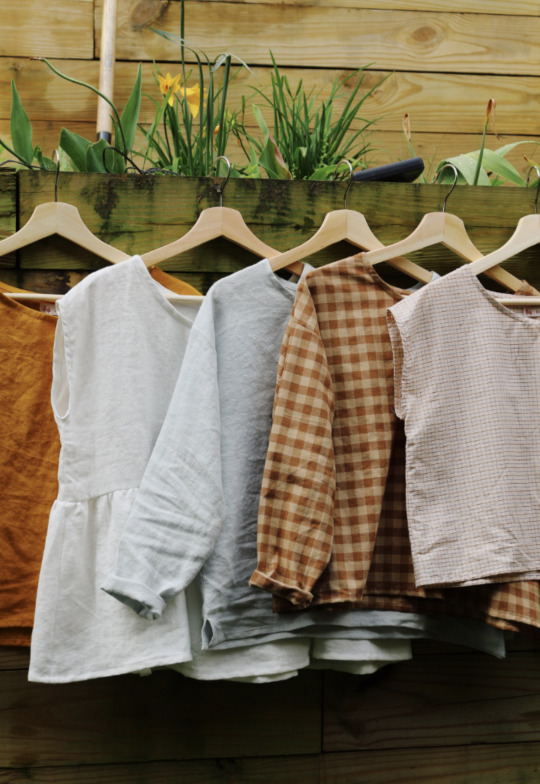
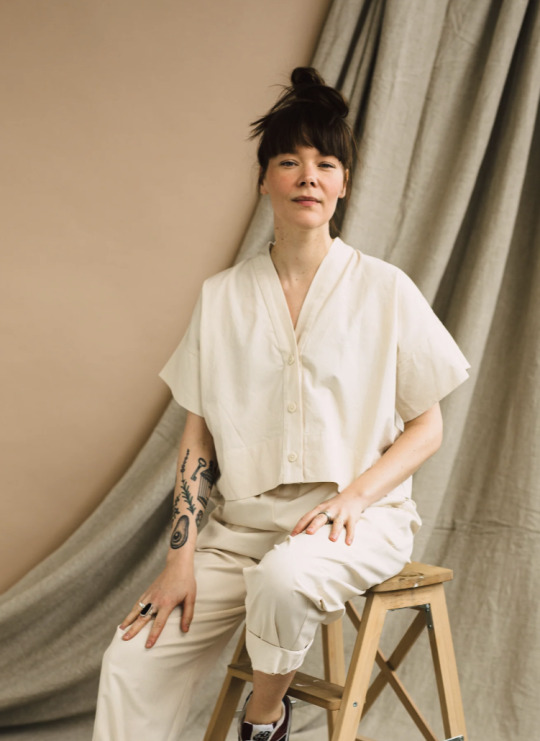

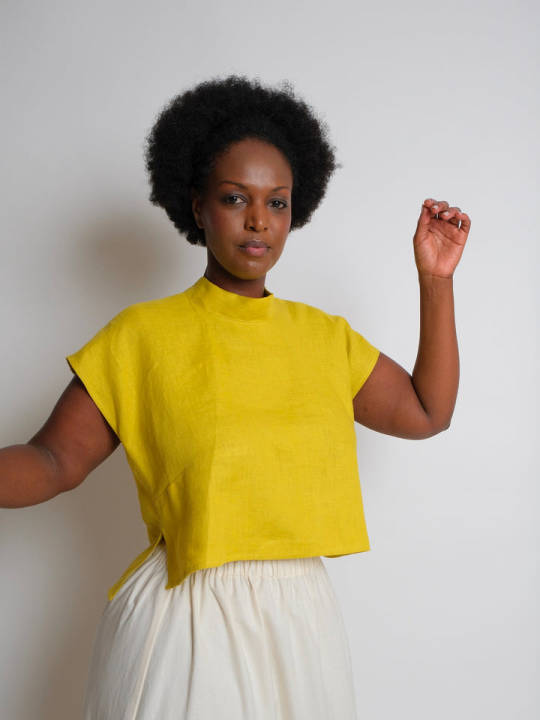
top left: all well box top is the ultimate versatile piece. you can make it sleeveless or log sleeves, cropped or long, add ruffles, change the hem, the choices are yours and it's got a hacking guide that tells you how to do all of it. this is my go-to shirt pattern that i make for myself and i think about 1/4 of my wardrobe is variations of this shirt lol.
top right: birgitta helmersson zero waste cropped shirt, this can also be made short or long sleeved and has the added bonus of being a zero waste garment, ie. not a single scrap of fabric is wasted. you can customize the size of the shirt to your measurements. i've made both short and long sleeved versions and they're great.
bottom left: phoebe linen tank (free pattern) is great, super simple to put together. it's sleeveless without a low neckline which i think would be right up your alley
bottom right: zero waste tie top also by birgitta helmersson, i love her zero waste patterns. i've made the short sleeve version and want to make the long sleeve one as well, i love that it's reversible and customizable, and the zero waste aspect is great too.
all patterns fit me as a US size 20/22 and i believe most go up to a size 28/30 so they're pretty size inclusive.
105 notes
·
View notes
Note
Very excited to hear about the new button down design choices! I loved the look of your old ones but they just didn't work very well for me. I'm especially excited about the stretch cotton + gusset combination, because my hips are really a good 2 sizes bigger than my torso, which makes it very difficult to make a stiffer shirt work. And don't get me wrong, I don't expect you to accommodate for that specifically or anything, I just mean to say that I think this will get them within a workable range for me!
While the price is a little higher than what I typically like to spend on a garment, it's not TOTALLY out of my price range, especially if the shirts are good quality. Might just accumulate them slower than I have your skirts. 😁
glad you’re excited!
the stretch cotton is honestly SO nice. i’m a 52”/42”/58” and due to the stretchiness of the cotton, the 2X sample fit me well through the bust, waist and hips even without unbuttoning the gussets, which was wild! i would still personally choose to unbutton them just in case, but i was floored to discover that i could wear it at all without unbuttoning the gussets since the shirts are still straight cut (ie, same measurement thru bust, waist and hips)
75 notes
·
View notes
Text
Making late Medieval Fringe
Fringe was an important part of 16th and 17th century Irish fashion. In this post, I will discuss the historical evidence for its use and my attempt to reconstruct it.
Fringe shows up on Irish garments in several period works of art.
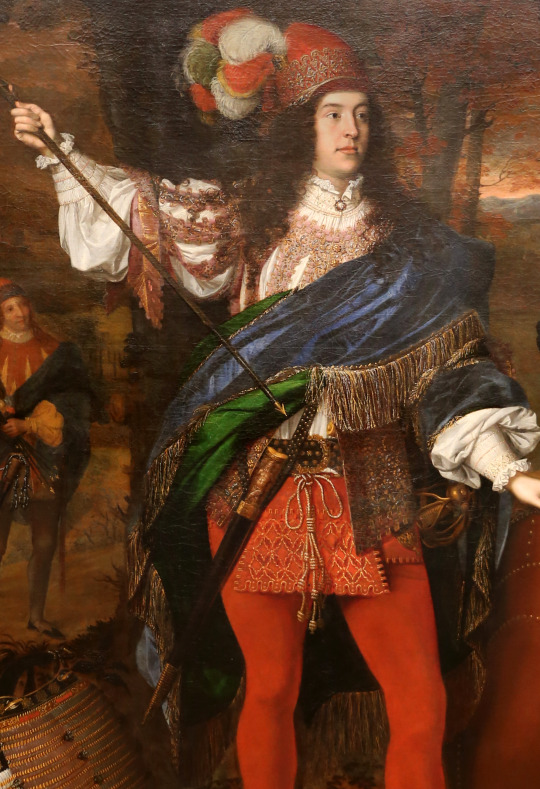
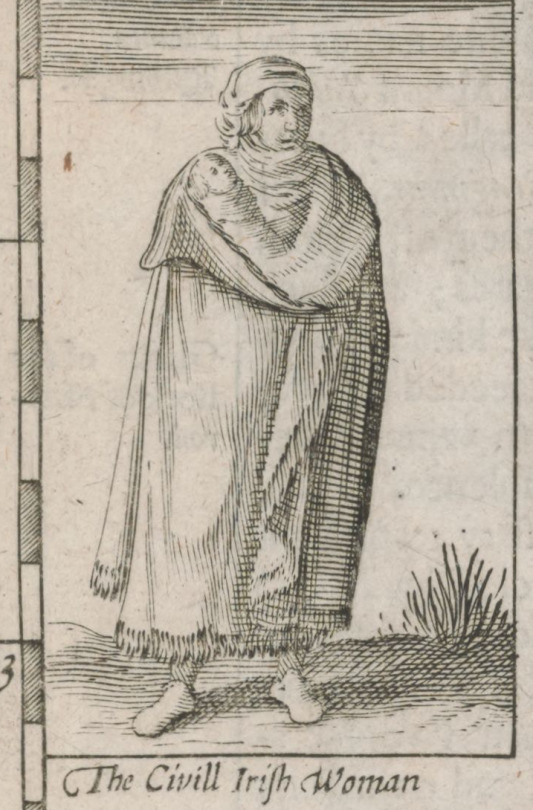
1680 Portrait of Sir Neil O'Neill by John Michael Wright and the 'Civill' Irish Woman from John Speed's 1611 map of Ireland, both shown wearing a fringed brat (Irish mantle).
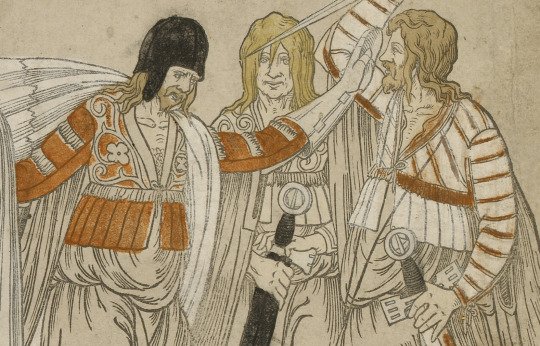
Detail from 'Drawn after the Quicke', an anonymous 16th c. English print showing Irish men wearing ionair (Irish short coats) embellished with fringe.
Historical Research:
The Irish use of fringe is mentioned by several period writers. In 1548, Paolo Giovio stated that most Irish men wore, "a soldier’s woollen cloak, with a fringed and variegated edge for elegance" (translation from Harris 2007). Similarly, William Good said Irish men and women wore "mantles or shag-rugs [. . .] fring'd round the edges with divers well mixt colours" (1586/1695). 17th century writers Luke Gernon (1620) and John Lynch (1661/1850) both described how the Irish continued to wear fringed mantles in spite of British colonial laws banning them. Gernon stated that the Irish mantle (ie brat) "differs nothing from a long cloke, but in the fringe at the upper end, which in could weather they [the Irish] weare over their heades for warmth," suggesting that this use of fringe was such an important part of Irish fashion that it was a marker of cultural identity.
This fringe appears to have been a separate trim, typically made of wool or silk, that was added to the garments. This is suggested by John Speed's description of Irish mantles as being "purfled with a deepe Fringe of divers colours" (1611). Applied fringe trim can be seen on the brat in Sir Neil O'Neill's portrait. In his poem "A Vision", 16th c. Irish poet Tadhg Dall Ó hUiginn describes a fairy woman wearing, "A purple mantle with satin fringes" (1550-1591/1921). Fringes made of silk and wool are found among recorded imports to Ireland in the late 16th c. (Flavin 2011).
Despite all this period evidence, I sadly do not know of any extant examples of Irish fringe from this period. Since at least some of the fringe used in Ireland was imported, I decided to look at examples from other parts of Europe to determine how Irish fringe might have been made. Looking at 15th-17th c. examples in the V&A, I saw 2 common manufacturing methods: warp-faced plain weave and tablet weave.
I decided to go with tablet weave for this project, because tablet woven bands have been found at earlier Medieval sites in Ireland (Wincott Heckett 2002). Following the historical costuming advice of The Welsh Viking that simple things less likely to be wrong, I used this simple late-15th c. fringe from Sweden as the basis for my pattern. Simple tablet-woven fringes continued to be used into the late 17th or early 18th century.
I used wool yarn for this project, because I wanted something that could have plausibly been made in Ireland and afforded by Irish commoners, instead of a luxury import like silk. Wool also seemed like the best fit for John Lynch's characterization of the fringe on a brat as a practical feature which protected the wearer's neck from the rain (1661/1850). I chose blue based on a combination of the availability of woad in 16th c. Ireland (Flavin 2011), the noted fondness of the Irish for bright colors (McClintock 1943), and personal preference.
My reconstruction:
I used Garnhuset wool weaving yarn I purchased from Vävstuga Weaving School in size 20/2 for the warp and 28/2 for the weft. (Check out this video, if you need an explanation of how tablet weaving works.) I made a box loom out of a cardboard box, although I suspect that any loom type that works for tablet weaving would also work for this.
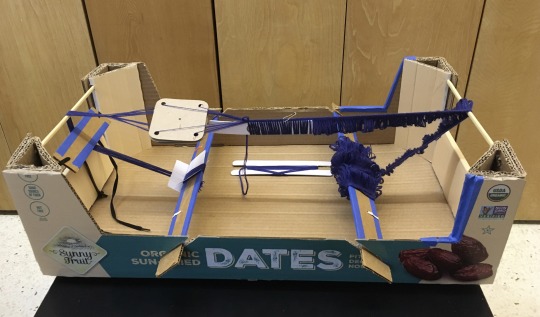
Also used bamboo chopsticks, tape to cover the rough edges of the cardboard, and a shoelace. Not pretty or historically accurate, but cheap and easy to make.
My tablet weaving pattern uses 6 cards. Cards 1,3,5 are Z threaded. Cards 2,4,6 are S threaded. All 6 cards are turned in the same direction until too much twist is built up on the warp to continue, all 6 cards are then turned in the opposite direction until too much twist is build up to continue. Reverse direction and repeat until you run out of warp.
For the weft, I used 5 strands the of 28/2 yarn run together as if they were a single weft thread. I placed a rectangle of sturdy cardboard against the left side of the warp and looped the weft around it as I wove. I neglected to get a good picture of this on my actual loom, so here is a picture of my test piece setup.
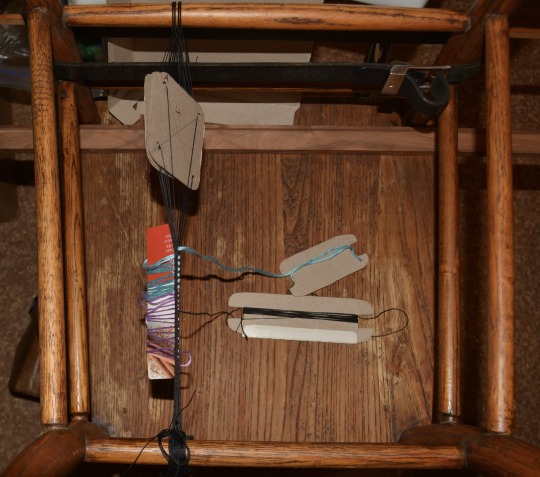
The relevant part here is the light blue and purple threads. Ignore the shuttle of black thread.
As I advanced the warp, I slid the cardboard rectangle forward to continue weaving. After I took the completed fringe off the loom, I took a pair of scissors and cut the bottoms of the weft loops.
If you try this, I strongly recommend covering the long edges of your cardboard rectangle with tape. This will both protect your warp from being chewed up the cardboard and make the cardboard more slippery and easier to to slide forward. Also, make sure you are beating the shed well and pulling your weft tight. Once you cut the loops, the tightness of your weave is the only thing keeping your fringe from pulling out.
Results:
I whipstitched the completed fringe to the edge of my brat. I am extremely happy with how this turned out. I had never done tablet weaving with wool before, so I had no idea what to expect.
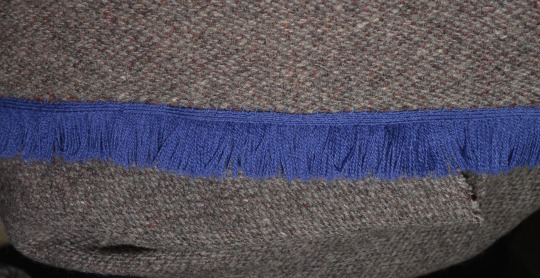
This method creates a thick, fluffy fringe which I think does a nice job recreating the look of "Drawn after the Quicke". You do lose quite a bit of length though. The wool yarn is kind of stretchy, and tablet weave is kind of stretchy (similarly to a twill-weave fabric). Between the ends of the warp lost to setting up the loom, and the stretchiness of the finished product, 11 ft (335 cm) of measured warp gave me 92 in (234 cm) of completed fringe. Oh, well. At least my loom can easily accommodate a longer warp, and this piece only used 20% of my 2 skeins of yarn.
I did also make a test piece out of DMC Pearl cotton. The warp is size 8 embroidery thread, and the weft is size 25 embroidery floss with all 6 strands used together. It is slightly easier to work with than the wool, (wool warps do have an annoying tendency to stick to each other), but I don't like the way it looks as much.
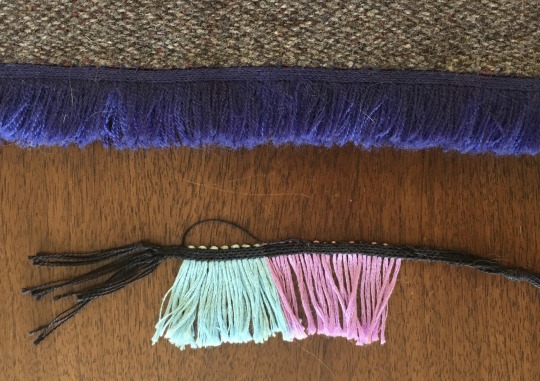
Wool fringe above, cotton below. Ignore the purple fringe. It has an extra weft thread that is not part of the fringe, which is why it looks more gappy than the light blue.
The cotton tends to stay in its discrete clumps rather than feathering out to form a nice fluffy, connected whole like the wool does.
I then went to the Ren Fair and located an appropriate sword.

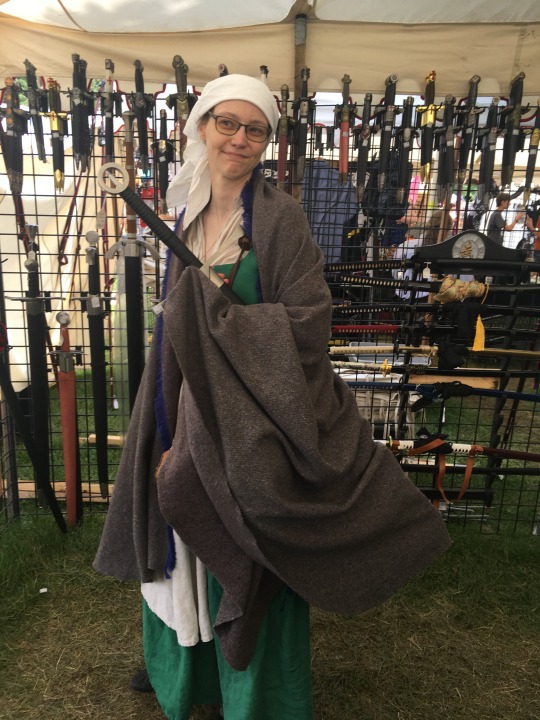
(Yes, that's an English kirtle and smock. I haven't finished making my other Irish garments yet.) Me carrying a sword a la Albrecht Dürer's kern.
I really should have made this fringe longer. It's only 1 in (2.5 cm) long. Looking at the scale of Speed's "Civill" woman, I would estimate that hers is closer to 2 inches long. I may add a longer second layer. John Lynch does say that the brat has a doubled layer of fringe in the neck area (1661/1850). Adding a second color to the weft would probably better match William Good's description of "divers well mixt colours" and Paolo Giovio's "variegated," but I like the way the solid blue looks.
As a bonus, I will say that the wool fringe feels softer and nicer than the cheap coating wool I used to make my brat. I suspect that may be part of the reason the 16th-17th c. Irish were so fond of having thick fringes in the neck area, to protect the skin of their necks from the irritation of a brat made of coarse wool. The léine would have protected most of their body, but it largely left the neck bare.

Irish woman wearing a brat with a deep fringe by Wenceslaus Hollar published 1643
Want to give me a tip? Ko-fi page
Bibliography:
Flavin, Susan (2011). Consumption and Material Culture in Sixteenth-Century Ireland. [Doctoral thesis]. University of Bristol.
Gernon, Luke (1620). A Discourse of Ireland. https://celt.ucc.ie/published/E620001/
Good, William (1695). The Ancient and Modern Customs of the Irish. In W. Camden (ed) Camden's Britannia newly translated into English, with large additions and improvements; publish'd by Edmund Gibson (p. 1042-1048) (Edmund Gibson, Trans.). Edmund Gibson. (Original work published 1586) http://name.umdl.umich.edu/B18452.0001.001
Harris, Jason (2007). Ireland in Europe: Paolo Giovio's "Descriptio" (1548). Irish Historical Studies, 35(139), 265-288.
Lynch, John. (1850). Cambrensis Eversus (Matthew Kelly, Trans.). Dublin: The Celtic society. (Original work published 1660) https://archive.org/details/cambrensisevers04kellgoog/page/200/mode/2up
McClintock, H. F. (1943). Old Irish and Highland Dress. Dundalgan Press, Dundalk.
Ó hUiginn, Tadhg Dall (1921). The bardic poems of Tadhg Dall Ó Huiginn (1550–1591) (Eleanor Knott, Trans.). (Original work published 1550-1591) https://celt.ucc.ie/published/T402563/index.html
Speed, John (1611). The Theatre of the Empire of Great Britaine: presenting an exact geography of the kingdomes of England, Scotland, Ireland, and the iles adioyning. William Hall, London.
Wincott Heckett, Elizabeth (2002). Irish Viking Age silks and their place in Hiberno-Norse Society. Textile Society of America Symposium Proceedings, 427. https://digitalcommons.unl.edu/tsaconf/427
#irish dress#16th century#17th century#irish history#historical men's fashion#historical women's fashion#historical costuming#dress history#fringe#irish mantle#bratanna#historical reconstruction
37 notes
·
View notes
Text
Oh god, now I'm thinking about the overlap between Diggers(especially with his Manus Vindictae garment) and Horropedia...
I mean... I've thought about it before, I just didn't post about it.
We all know that Horropedia grew up in the SPDM (aka, the school that the St. Pavlov Foundation is controlling), and we know from watching Vertin's experience that it is not a nice place to grow up in.
Likewise, Diggers is a student of Manus Vindictae. Although, we don't know for how long, it's most likely only been about as long as Regulus has been working with Vertin(ie. Not as long as Horropedia). But, the fact he is an arcanist means that he did have to go through some good old prejudice from humans, because humans tend to have very closed mindsets, and humans don't like arcanists.
They both have an affinity for math, Horropedia using geometry to his advantage in his attacks and Diggers is currently studying mathematics as part of his being a student for the Manus and all that.
They also really enjoy art, although they have different tastes. Horropedia stays up until sunrise just so he can make time for enjoying horror stories. Diggers is a night owl who canonically does graffiti and plays guitar in his spare time.
They are also very rebellious, although their rebellion is mostly just wanting more freedom and control over their lives.
They want the people around them to be happy, and know that they care, and remember them...
And then people are driven away because of how annoying they can be.
We need them to hang out more often. Can the rest of the fan community help make them hang out more often?
#reverse 1999#reverse 1999 diggers#horropedia#my little guys#my scrunkles#they need therapy#and a nap
49 notes
·
View notes
Note
Hello! You've been super nice with my content and I would like to thank you for being so kind 🥺
I have a question since I'm interested to ask! Can you tell me something about your culture and Samoan people? :D
Of course dearie! Everything that you've created is an ABSOLUTE stunning art! You and the others that I have followed!
And yeah! I would LOVE to! But just to let you know, I’m slowly learning as well since I was young. Because of how a slow learner I am but I will do my best to answer your question! (And it will be in a little detail for me to explain EVERYTHING about our culture.)
Starting off about the Samoan people. Us Samoan people are very strict with our culture. And they said that we're the most recognizable people showing it.
Our dances, our music, visual arts. All of that! The Visual Arts are the most interesting thing that I've seen so far.
Like the Tatau (tah-tah-oo).

The Tatau are like tattoos mainly on the thighs and waist. You can say that they're wearing like clothing. Which means they are practically...Ahem. You should know. And they said we started using this as an inspiration by the two Fijian women who came up to the shore and brought their materials and knowledge of tattooing.
Next one that we're known for Visual Arts is Siapo (see-ah-poh). A Samoan word for "A fine cloth made from the bark of the Paper Mulberry tree."
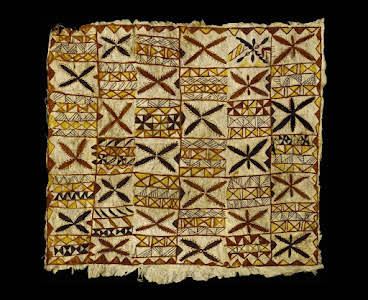
The Siapo is very important for ceremony, especially the wedding occasion and the funeral service, just to wrap the dead body and put in the grave. (Since we have caskets now. We put the Siapo on TOP of the casket instead.)
It's even for High Chiefs or village maiden wearing the Siapo around their waist. Like in this old photo!

(IF you can even SEE it)
Now the next one is the Ie Lavalava (ee-eh lah-vah-lah-vah).
An Ie Lavalava is a piece of fabric that Polynesians tie around their waists that gets worn like a skirt. Both men and women wear this type of garment in Samoa and is considered to be a traditional daily outfit used for school uniforms or work attire paired with a jacket and tie.
Like this one:
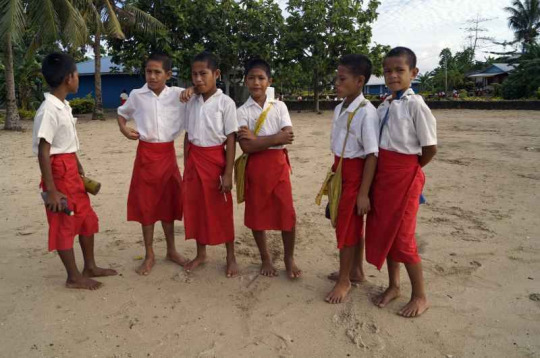
(Students wearing their Ie Lavalava for school)
Or this one:

(This is somewhere in the state as they allowed them to wear it in school campus. I forgot the name of the school and place.)
Men and Women wear them like that. For anywhere they go. Back in the days, my dad use to tell me that women should wear an Ie whenever they go out in the village. If they don't, it goes to show that they are not respecting our people or the village for it.
And nowadays, we hardly done that. I mean, there are still some of them wears an Ie when they go out but most of us aren't. I only wear an Ie when I go to another Pastor's house or go to Church.
Anyway, here is some BEAUTIFUL design that they made an Ie Lavalava!
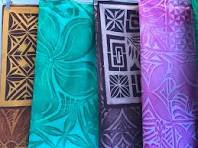

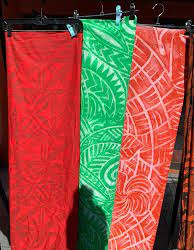
And LASTLY of the Visual Art, is Weaving. I'm sure you already know of what weaving is. For us, we weave baskets and Ie Tonga (ee-eh toh-ngh-ah).
It's like the Ie Lavalava but it is made of native pandanus (lauie) tree. And it's BIGGER. I forgot if my dad told me if it was the BARK or the LEAVES they use to make it. Here is what the Ie Tonga look like:
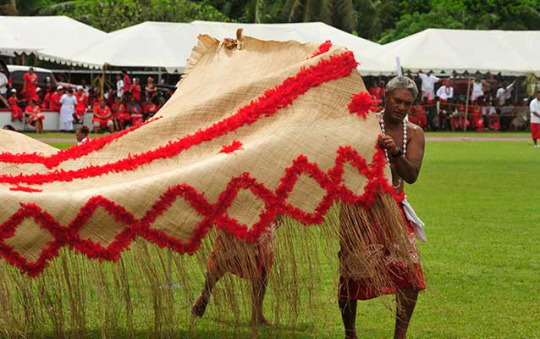
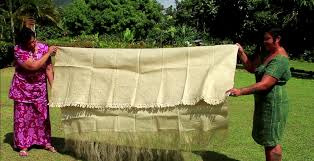
Just like that! They use these for the funerals as a gift to show their respects. I've seen this MANY times. They use these for Fa'alavelave (fah-ah-lah-veh-lah-veh). Means "Families dig deep to help fund funeral, wedding, or other life-interrupting costs, to the tune of thousands of dollars."
And oh yeah, the Samoan funerals also involves money. To help out to get the things for the high chiefs and other pastors and wives.
ANYWAY, they said the I'e Toga originated from our neighboring country, Tonga. The I'e Toga was originally brought to Samoa by a Tongan lady named Fuka (foo-kah). Fuka's older sister, Lautiovogia (lah-oo-tee-oh-voh-nee-ah) the Queen of Samoa, was married to the King Tuiatua (too-ee-ah-too-ah). During Fuka's visit to Samoa, she gave her sister an I'e Toga as a gift.
And that's how the Ie Tonga came into Samoa.
That's about it for the Visual Art. And for the music and dances. The dancing is mostly about elegant and grace. The dances also tells the story about our ancestors and mostly about love. Just like any other countries uses their music in dancing to tell the story!
Another thing about us Samoans. Samoan parents are VERY strict of disciplining their children. Like let's say....Mexican/Asian/Black mothers disciplining kind of way😅.
But they're just doing that out of love. Nothing abusive. I promise.
And also, there are TWO different Samoa island. One island is named ACTUALLY Samoa and there's AMERICAN Samoa (That's where I'm at right now!). The differences is.
Samoa are like the independent one. Nothing owns them. Until New Zealand took Samoa under them.
While American Samoa is under the US. If I remember correctly the reason why American Samoa is under the US. Is because of the Americans assisting us from the war that is going on. Going against Germany, I think.
So I guessed that's how we became under the protection of the US.
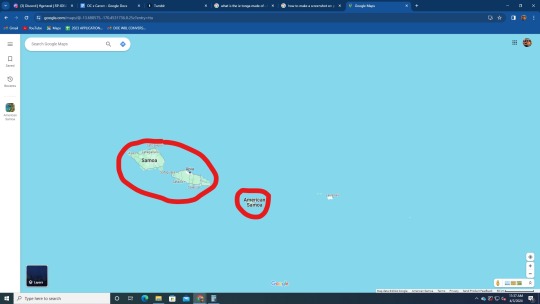
Here are the two Samoan islands. Almost close but it's like 1h 12m on an airplane and 16h on a car ferry. I prefer the plane (If I didn't pack anything HEAVY. Lol.)
So yeah, that's about it. Thank you @welldonekhushi for the ask and hopefully this will help you answer your question! I'm trying be detailed as I can.
#culture#samoan culture#learning the culture#answering asks#samoan people#samoan ancestors#history#history lesson
20 notes
·
View notes
Text
LFRP: Diarmune Rhet-Khas

Character Name: Diarmune Rhet-Khas
The Basics ––– –
Age: 55
Birthday: End of Summer
Race: Viera
Gender: Male
Sexuality: Pansexual
Marital Status: Single
Physical Appearance ––– –
Hair: Quite long and silvery white. It is almost always pulled up in a ponytail. When down it is long enough to sit on (Hence why it is always up)
Eyes: Pale Green
Height: 6"1'
Build: Athletic and fit
Distinguishing Marks: Minimal scars from years of working with dangerous plants and animals. Two sleeves tattooed in a vine and floral pattern with a flower on his shoulder.
Common Accessories: His Gleaner gear, a journal, some kind of plant or flower probably...

Personal ––– –
Profession: Gleaner
Hobbies: Botany and Horticulture
Languages: Common (With a Thavnarian accent)
Residence: Thavnair/Sharlayan
Birthplace: Thavnair
Religion: The Twelve
Relationships ––– -
Spouse: None
Children: None
Parents: Father: Elías- Alive/Silk Maker | Mother: Myra - Alive/Tailoress
Siblings: Sister (Older Twin): Sofina - Alive/Student | Sister (Younger Twin): Helina - Alive/Student
Other Relatives: None that he knows of.
Pets: Korpokkur (Named Plum), Great Morbol (Named Dahlia)

Traits ––– -
* Bold your character’s answer.
Extroverted / In Between / Introverted
Disorganized / In Between / Organized
Close Minded / In Between / Open Minded
Calm / In Between / Anxious
Disagreeable / In Between / Agreeable
Cautious / In Between / Reckless
Patient / In Between / Impatient
Outspoken / In Between / Reserved
Leader / In Between / Follower
Empathetic / In Between / Apathetic
Optimistic / In Between / Pessimistic
Traditional / In Between / Modern
Hard-working / In Between / Lazy
Cultured / In Between / Uncultured
Loyal / In Between / Disloyal
Faithful / In Between / Unfaithful
Additional information ––– –
Smoking Habit: Nope
Drugs: None
Alcohol: Very rarely, he is quite a light weight and suffers terrible hangovers.
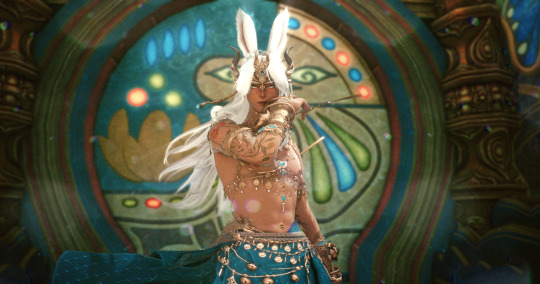
RP Hooks ––– –
SHARLAYAN:
While much of the Viera's time is spent away, he does return to his Sharlayan home from time to time, whether it's to bring in a specimen or to simply visit with old friends, he is not to difficult to find there, particularly as his clothing tends to standout against the more conservative and neutral tones of his Sharlayan counterparts. As a significant contributor in his field of study to the vast library over his three decades of work, Dia is most likely found there, but also will peruse the market and visit Labyrinthos from time to time. Especially if any of his projects are flourishing.
THAVNAIR:
Born and raised in Thavnair, Dia spent his entire youth there with his family. They are prominent silk makers and tailors, specializing in ornate and delicate garments. He's very familiar with the locals and after the panic of the End of Days subsided, Dia visits far more frequently. He's often found in the Radz-at-han market, out by Palaka's Stand, or in the silk factory pitching in to help his parents. A Thavnarian born, he has an identifiable accent and tends to wear garments that connect him to his home.
GLEANERS:
Are you a Gleaner too? Then there is a good chance you have crossed paths with him at some point in time, especially over the years of intense gathering in preparation for the End of Days. Due to the nature of his work (Specifically in regards to dangerous plants and plant-like creatures, IE: Morbols) it's very likely your Character might work side by side with him, or at least in the same vicinity.
TRAVELS/IN PASSING:
There are very few places on this grand shard that Dia has not been, which means his availability to meet people is vast and ever expanding! Perhaps you came across him at an Inn, or aboard a ship? Maybe you met him in one of the main cities, or out in the boonies of the continents... Regardless, Dia can be basically anywhere necessary to meet your character. (Note: Not the First however, I'm fairly lore strict on this point since only the WoL can freely travel back and forth at this point in the story and he is not a WoLPC.)

Contact Information ––– –
I would prefer to be contacted via Tumblr first before giving out my Discord.
In game and Discord RP works for me, though I prefer in game.
His Carrd: https://diarmune.carrd.co/
23 notes
·
View notes
Text
Bard's Broken Heart
I present: 1 motif of what I’m calling “Bard’s Broken Heart Lace”
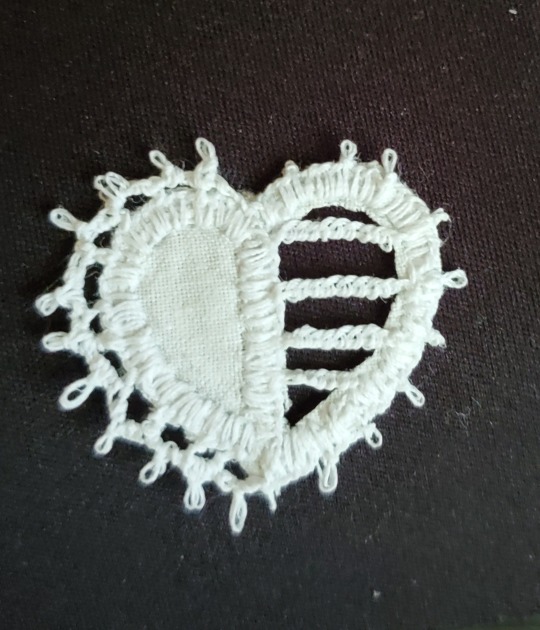
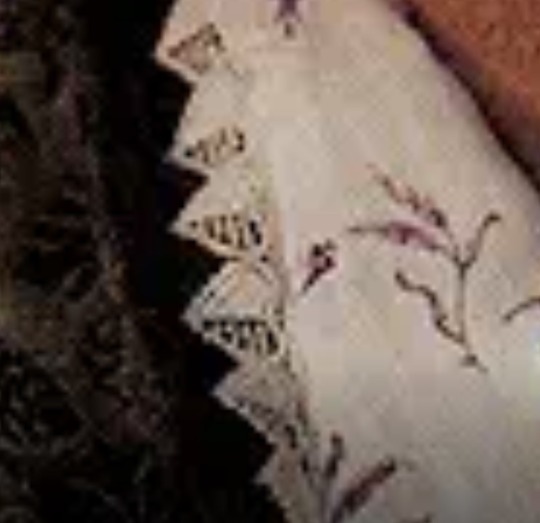
OK, not quite, but still a cool design.
Inspired by this post from Tumblr user @loki-is-my-kink-awakening
https://www.tumblr.com/loki-is-my-kink-awakening/723753602720661504/oh-my-gods-are-these-the-hearts-hidden-on?source=share
Who noticed that the trim on Jaskier’s shirt in Season 3 Netflix Witcher is little hearts! And a reply (sorry OP, I can’t find it now) noted that they’re very symbolically, hearts that are divided!
So anyway, I got crafting-obsessed and had to try to figure out how it was made and attempt to recreate it.
Which lead to research on historical lace-making and needlework.
[Disclaimers: this is all my best guesses as an amateur crafter, not a historical expert.
I know my stitching is uneven, especially the pin-picots, which I just learned last week]
by the way, crafters or fic writers looking for historical fibercraft reference, check out Project Gutenberg’s (free!) The Encyclopedia of Needlework by Thérèse de Dillmont https://www.gutenberg.org/cache/epub/20776/pg20776-images.html
SO much fascinating stuff!
First, based on the clearest photos I can find (ie not very) I’m guessing the actual trim was machine-made, because a) the stitching is really even and smooth and tiny, b) handmade lace would be extremely expensive, and c) TV/Movie costuming needs multiples of every garment, especially for something like a delicate chemise Jaskier wears running all around the continent for a whole season.
My first guess and attempt was crochet, which wasn’t it, then thought it might be tatting or bobbin lace, which also weren’t right once I looked up images.
I finally settled on whitework cut-work embroidery with some needle lace techniques for the edging. Which I think gave me a kind of close facsimile. This one is about 1-½ x the size of what he wears (because that’s the limit of my aging hand steadiness, crafting magnifiers, and the materials I had.)
This one motif took me probably two hours, including many screwups and tangles. Not including drafting, blocking and snapshots. With the right materials and one done for practice (as it was only my second project in whitework and first try at needle lace!) one heart would take around an hour. For someone whose lifelong job, all day every day, was embroidering lace trim, they’d probably manage a meter/yard or two of the actual size trim, which I’m guessing is how much is on that shirt.
So in-universe, this still wouldn’t be a cheap piece of clothing, with at least a full day of skilled craftswomen wages for just the lace, plus finely woven, printed fabric that (I think, historically, that would have been block printed by hand), and additional seamster time to make it up. Modern-day equivalent would probably be easily USD $1000 if not 2x that. Our boy is making good money as a now-famous bard! (I suppose in a universe with magic, it could have been magiked, or magically duplicated after an expert created a template, but I suspect that would cost as much as handcrafting anyhow)
If I get bored and the crafting bug hits me again, I might try to make a whole edging this, maybe on a handkerchief.
Now, what do I do with one lace heart? I settled on starching it and attaching a safety pin back, so I guess if I ever go to a convention I can wear it as a pin so fellow Witchercrafters and Jaskier fans know how much of a nerd I really am.
I could write up direx with step by step pictures if anyone else really wants to try it.
#the witcher#fanart#fan crafts#netflix the witcher#witcher season 3#needle crafts#costume details#lacemaking#witchercraft#jaskier
46 notes
·
View notes
Note
I'm on my knees BEGGING for an Austin Powers cosplay from you holy shit you would make it insane!!! Side question: My biggest issue I have with sewing is deciding which fabric I should use for specific projects/pieces. Trying to find an answer on that online is not easy as usually tutorials just say like "With your fabric, do X" without saying which fabric to look for 😭How do you personally choose your fabric when doing your cosplays? Do you have a cheat-sheet of like what to look for?
I'm about to have a micro-lull in projects so who knows! maybe now is the time for Austin Powers.
To tell true, my strategy for choosing fabrics is kind of a goofy one. if you look at everything i've made, you'll notice that I tend to use a lot of the same fabrics repeatedly. Microsuede, mystique spandex, pleather, stretch twill/sateen, stretch denim, and matte satins. I dont have a lot of access to fabric stores anymore where I can go in person choose it based on inspection, so instead I take what I know and work with it! So I tend to either choose projects based on a fabric that I'm familiar with, or I take the design and make it compatible with one I like. for example on Thistle, i'm sure using something like taffeta, dupioni, or velvet wouldve worked for his design, but I chose microsuede because I like it and I leaned into properties it has like a textured appearance and stiffness.
But that being said, even if you help yourself by working with a more limited scope of fabrics, how do you choose between fabric A and fabric B for an application? Typically what influences how a fabric behaves is its weight (ie is this a super light fabric that blows in the breeze, or something heavy like what you might find on a couch), its drape (will this fabric hang straight down or be stiff and fold more like paper), and its finish (is this something shiny and reflective, or matte? does it have a texture, or a totally smooth surface?).
in general if you want something fitted and structured like a crisp jacket, bodice, or a skirt that holds its shape, you tend to want heavier, stiffer fabrics. if you want something to look soft and flowy, then lighter, more draping fabrics are best. (thers also the mechanical issue that if you're working on something big like say a ballgown, if you chose a heavy fabric, you will need to account for the scaling weight. making a short skirt vs a long skirt out of a heavy fabric will have very different outcomes.) it's hard to give specific advice about fabrics in general, since each project has its own specific needs and each project can be made with any variety of fabrics, but will result in different appearances in the overall garment.
BUT i do have a mini word of wisdom, which is if you have a fabric in mind but you're not sure it will work, you can always try looking up like....."matte satin dresses", or "suede jackets" and see if you can find any examples of the fabric you're thinking of being used in the garment you want to make (or in general) to check if it gives the look you want. you can even go backwards and look up like...."prince costume" and try to identify common fabrics that usually come up for that garment style.
12 notes
·
View notes
Note
What is the significance of inventing the Shihakushō - why did she actually invent it and why was it worth a 'promotion'?
All right, I'm now mentally in a place to do an hc of something this integral as a concept. So--lets journey!
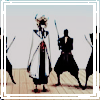
First, lets think about what the shihakushou is and how it behaves. I think that it actually has a lot to do with some of her cohorts, as it makes sense to me that her own abilities work with, and are shaped by the powers of her closest friends—as Oetsu invented the asauchi/zanpakuto, and Tenjiro invented healing kaido. Shutara’s strengths are not in what she is herself…but how she can see the spaces between.
One cannot have one without being a ‘shinigami’, but canonically it’s not necessarily true that a shinigami is aware of this fact to the profundity of its truth. If you follow the narrative from inside the Seireitei, it’s given to a shinigami—once they graduate from the academy, the wearer moves from dressing in the student robes to the professional garb of the black shihakushou. Yet it can also be manifested when one suddenly becomes a shinigami—such as when we see Ichigo’s power come into existence with a shihakushou automatically. I strongly believe he was clothed transdimensionally. GIven that Oetsu can canonically understand who has a zanpakuto and what condition they're in--it makes sense that she has a mirrored ability in her own connection to cloth and wearer.
A shinigami’s shihakushou will go fully white and altered in form if a shinigami tranfers all of their Reiryoku, as in the case of a shinigami transferring their powers to a human via a zanpakuto. In certain cases like with Unohana speaking to Ichigo about her healing, his own shihakushou’s tattered state was tied to the fact that his reiryoku was in tatters even though his physical body was in good shape after being healed in Hueco Mundo. It’s intimately tied into the wearer, their status, and the qualities of their soul.
So…given that in order to truly ‘wear’ a shihakushou as intended, one must a) have an energy that can harmonize with the fabric (ie be a being with shinigami-like spiritual power), b) have the potential to command a zanpakuto—even if it’s not well understood by the user, and c) harmonize with the fabric enough to let it become one with you to allow for others to heal you, see your status, protect you, and it allows for your identity to blend with others even when you are displaying in the state of the garment how you are as an individual.
Uniforms are powerful statements. It identifies one as part of a group to an outsider, as well as fosters a group identity in an individual when worn. It is a statement of teamwork. And of course as a leader of the Divine Blades, she understands a plain uniform that must blend in, but allow for exceptional work It is not lost on Shutara that there are much flashier inventions in Soul Society. However, as simple as a black garment may seem, it is equally complex as the creations of those she works beside. The work of Tenjiro’s healing on a person can be seen easily on the body—but through cloth, you can see what’s not there overtly, and its so simple that even someone who cannot sense reiatsu could find someone injured, see the gravity, and get them help. Oetsu’s work is honored in tying the ability of the fighter and their weapon into one readable unit. It’s simple as breathing to her to think about who is beside her and what they need. Just the same as the fact that she lends her name to the Shutara scale used in alerts, Shutaras abilities exist to keep many under her protection or her thrall, and she doesn’t much care that her abilities are defensive in nature; she cares about the sheer number she can save. She is the humility of Toyouke, goddess of cloth and necessity, dressed up in the resplendence of Amaterasu, goddess of silk-making.
She is known for being an illusion caster in a group setting who must keep MANY in mind. She is a living avatar of the importance of fighting beside and for others instead of as a single warrior obsessed with their own strength and power—this is a difference and not a weakness. If she is in battle, she is not doing so on her own unless the straits are dire. There is strength in numbers and relying on your team. She has made a basic, humble cloth, that makes people in fandom wonder why that is an ‘invention’ in the first place…let alone one that would place her in the Guard. But that’s precisely why she’s there. She fills in gaps, highlighting the strengths and buffering the weaknesses in her comrades. The oldest protection spells in human history are knotwork, clothing your family in the power of your love spun in cloth--and this realty isn't lost on me. Her own gift is just as cloth is…something that ties together people and keeps them covered. And even more than that, like any woman’s work—easily taken for granted.
#tsp activity check#senjumaru shutara#(the webs we weave) identity#(truths of the priestess) answers
23 notes
·
View notes
Text
Garments IE work area
IE department is the important part of the Garments industry, they must perform some basic tasks on a regular basis. Today I will try to classify garments ie work area & regular activities and dealings in a short to make you understand their importance in apparel industry. Let’s take a quick look at their regular garments ie work area.
The primary function of the IE team is to hire skilled labor for the production floor, provide training, evaluate worker performance, motivate workers, reduce loss time and waste, and maximize profit margins. I attempted to combine regular activities and duties of the IE department that they typically perform in order to improve product quality and productivity.
1 note
·
View note
Note
when and why'd everybody switch from corsets to bras? (I don't got tits so you might have to explain things from a fairly basic level.)
well okay so i’m not a garment historian but:
Relevant Background:
I’m not sure what kind of garment you think of a corset as? If you’re thinking of something very stiff and restrictive, then you’re thinking of something that was never everyday wear for working women (ie the majority of women) anyway, although towards the end of the corsetry era with the development of cheaper production methods and plastic boning a working class woman with a decent job might’ve owned one to wear on Sundays. Working women did wear supporting garments that were corsetlike in structure (sometimes called stays, although the terminology isn’t strictly differentiated) and these were quite practical to do physical tasks in so long as you had the knack of moving in them.*
Tightlacing (the use of corsets to achieve significant reduction in waist size over time) was always a fad restricted to a small number of trendy rich women and was condemned by medical and moral authorities at the time. Fashion corsets for richer women still might achieve a fair few inches waist reduction, but:
the primary purpose of foundation garments such as corsets was never waist/size reduction, it was about achieving whatever was the fashionable silhouette or shape (while keeping everything ‘supported’, including the breasts). Early off-the-rack clothing for women was developed in the corset/stays era, and the notion of taking a single shape and sizing it up and down makes way more sense when you imagine it in the context of the expectation that everyone is being foundation-garmented into the same vague shape!
average/ common-to-have breast sizes in European women (both absolute volume, and breast size relative to torso diameter (which is what bra ‘cup sizes’ measure) have increased significantly since the early 20th century.
So,
When?
Between the 1920s and 1960s.
This is the era when the bra first appears, initially just as an innovation in the design of foundation garments, which have always changed in form frequently anyway - with new developments in terms of available fabrics, shaping technology and closures, and of course for reasons of fashion (which are sometimes downstream of the above, new things often being popular with designers and trendsetters).
The new corset/stays is a two-piece made up of the new brassiere and a sort of underbust stays called a girdle, but traditional corsets remain in use for some purposes - they’re still popular in bridal wear for instance.
The brassiere in this era features various innovations in garment technology such as underwiring (a variation on metal corset boning that achieves slightly different things in terms of torso shape (and feel/weight distribution, but not in an ‘unambiguous improvement’ way)) and elasticated fabric (developed around the turn of the century, and a structural necessity for bralike objects).
Why?
well as usual in history, lots of reasons. A big factor was World War I, but not in the way people like to think.
There’s a sort of revisionist history about corsets. Many 20th century feminists (lacking in knowledge for a combination of culpable and non-culpable reasons, and doing that very common thing of taking rich women’s historical experiences as universal and primary source scaremongering as accurate reportage) liked to think of them as Tools Of Oppression. Pop culture - funded by advertisers who wanted to sell their newer clothing styles, and tbh ever-ready to imagine women as vain and useless and not having contributed anything to society until five minutes ago - was ready to back them up, and following this you get a lot of accounts that say the wearing of corsets was primarily ended by women’s liberation, which WW1 contributed to because it was the First Time Ever that women had jobs, which of course you can’t do in a corset. That’s an extraordinarily blinkered, middle/upper class view of who ‘women’ are! But upper/middle class women set the narrative, and their upper/middle class mothers and grandmothers wore very different and more restrictive garments than the majority of women, who have always been expected to work. However this narrative - and the fact that working did get middle/upper class trendsetters out of their restrictive garments (but not into the garments worn by working class women bc that Just Wouldn’t Do) - did contribute to the corset going away and not coming back.**
Moreover, WW1 helped kill the corset for 2 reasons:
during the war, the stuff to make corsets with was rationed/needed for other stuff to a greater extent than the stuff for bras, which use a lot less fabric.
after the war, which meant fabric shortages and rationing, a new look developed which allowed the rich (trendsetters) to demonstrate their wealth by being very loose and flowy. It lacked a defined silhouette that would have required traditional shapewear, so helped to cement the corset’s exit from the market. (This look was also highly feminine, and that was definitely a cultural factor in its popularity at this time.)
When people stopped wearing corsets, they stopped making comfortable corsets or innovating in practical ways in the design of corsets using modern fabrics and taking into account modern body shapes (as people have done with bras), so people are unlikely to find them more comfortable and be tempted to go back to them. We also stopped wearing so many layers of clothes all the time in general because of central heating, and (especially casual) clothing in the modern era has in general remained - for men and women - less fitted than it was in the past.
#*variously sourced but most interestingly to me this has been demonstrated by living history experts#**the girdle is still going strong however! it’s made of more high tech fabrics now and called shapewear or waist cinchers#garment history#weigh in if you know more than me#this is very incomplete there are whole books on this
65 notes
·
View notes
Text
Curiosity compels me
This is working with the following parameters
no one will suddenly walk in on you
in the one or the other categories you are wearing whatever undergarments you feel you need or none if such is your preference (ie. no top but a binder and bottoms/shirts and no bottoms, pussy out)
one piece garments such as dresses or jumpsuits count as fully clothed
I'm really trying to see if preferring to go topless rather than bottomless is as weird as I've been lead to believe. Tell me your clothing habits!
15 notes
·
View notes
Note
You know honestly I think fast fashion has made people forget what quality clothing is, like the people who are like, "$60!? No, this should be $15" are only saying that bc they only know what cheaply made clothing is like (ie that it wears out incredibly quickly). Like I would balk at work boots that cost $100 if my only frame of reference were $20 boots that wear out in 6 months (all this is to say I'm pretty sure your skirts are the most high quality garments I own lol)
yeah i do think it's partly that tbh
ive had some of our skirts for YEARS at this point, and while granted i tend to be relatively gentle on my clothing (washing on cold, using sensitive skin detergent and as little of that as possible + some borax, drying on tumble, etc), ive also heard from many other people who've been wearing the same skirt(s) they bought from me 5+ years ago.
it's just a whole different situation from anything even remotely fast fashion adjacent.
175 notes
·
View notes
Note
Idk why but it seems like since I’ve decided to quit/put in my resignation I’ve had at least one customer a day say that I need to keep working at the store? Like in a grateful way, and I don’t even mention I’m leaving, they just say smth along the lines of ‘I like you, you’re good at this, keep doing it.”
And it’s sort of weird/flattering, but mostly weird? What sort of interactions have you had in customer service that you think how I’ve conducted myself during our interaction is noteworthy? And it doesn’t feel creepy, or malicious, it’s just a weirdly specific thing that happens at least once a shift.
Anyway dumb/terrible thought… Frankie x craft store employee! meet cute cause his daughter is a menace with construction paper and glitter glue who wants to try/make a new thing every time he has her. (Also his favorite jacket has a hole in it and he has no idea what to do)
i totally get what you mean!! I think its because you like. genuinely want to make things at work smoother for yourself and customers (ie helping with coupons and such) and customers really appreciate that. I've gotten the same kind of compliments before when I give them the talk of 'if you buy this now its 20 percent off and you cant use a discount but if you wait two days it wont be on sale and you can use a 50% off coupon' and those moments are nice (sadly they are often lost in a sea of incredibly rude customers in an overhwelming shift)
also this idea is AMAZING because it's so on brand. Little girls love to craft and make the weirdest things and sometimes craft supplies can be so speicfic he has to go to a craft store instead of the usual like. walmart. Heaven forbid the sweet girl wants to learn how to sew? Oh his mother is telling him to take her to the fabric store so she can teach her how to make a dress (and now that he sees it. there is a hole in his jacket that's slowly getting bigger. maybe he can find something for that too while he's there) but he hasn't been in a fabric store in SO long. He remembers going when he was a kid with his mother but gosh things are so different now it feel like a whole other world so please imagining this sweet man coming up during a shift like 'hi, im so sorry to bother you but I have zero idea what im doing. Can you help me?" while his daughter hangs off his arms because she made a run for the tulle and he had to stop her from bolting off again.
but That being said?
I absolutely see Francisco Morales as the kind of guy who can do upholstery. We have guys who come in on a regular basis, often times the same men who work for upholstery businesses or car detailing that get the same fabric everytime and he gives off that energy. He'll come in still in his work clothes and always says hello, will make a comment about the weather or maybe pick up something small that he says his daughter will just love until one day he comes in with her holding his hand and all but dragging him over to the fabric because this year she's decided she wants to make her own halloween costume so they HAVE to get started NOW even though it's only may and he meets your eyes and mouths 'help' because he can hem his pants and fix the odd hole but sewing full garments is completely lost on him so you spent a good chunk of your shift leading him and his adorable little girl through fabric and sewing patterns and fall even more in love with him.
#ask#asks#I HAVE SO MANY THOUGHTS ON FRANCISCO MORALES AND SEWING+CRAFTS NOTE#francisco morales x you#i need to get back to sewing themed fics lol
9 notes
·
View notes